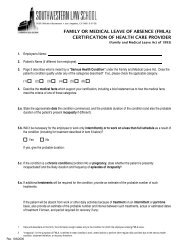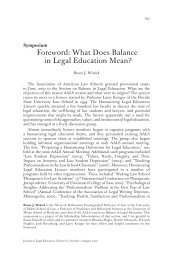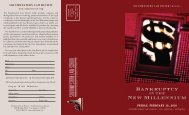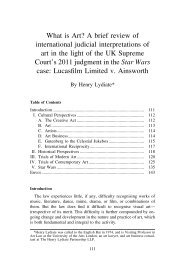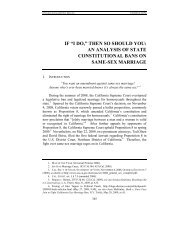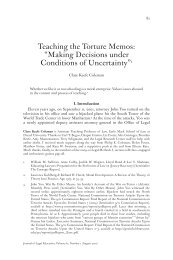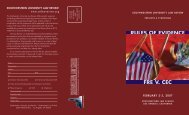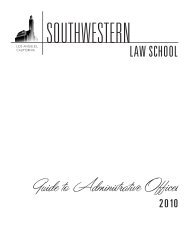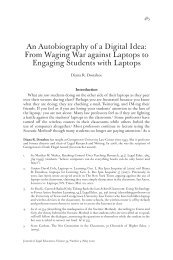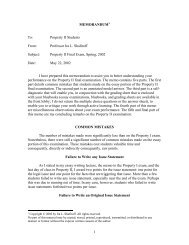demeanor evidence does not demean anything: how exposure to ...
demeanor evidence does not demean anything: how exposure to ...
demeanor evidence does not demean anything: how exposure to ...
You also want an ePaper? Increase the reach of your titles
YUMPU automatically turns print PDFs into web optimized ePapers that Google loves.
2013] DEMEANOR EVIDENCE DOES NOT DEMEAN ANYTHING 485was the trigger for the attachment of the Fifth Amendment because it fearedthat “[a]ny other holding would create an incentive for arresting officers <strong>to</strong>delay interrogation in order <strong>to</strong> create an intervening ‘silence’ that could thenbe used against the defendant.” 30 Therefore, someone who is arrested hasthe privilege against self-incrimination pursuant <strong>to</strong> the Fifth Amendmentand Miranda.II. THE CIRCUIT SPLIT AND DIVERGENCE OF OPINIONS AMONG THEFEDERAL CIRCUIT COURTS OF APPEALS OF POST-ARREST, PRE-MIRANDA DEMEANOR EVIDENCEThe Supreme Court of the United States has addressed the question ofpre-arrest, pre-Miranda silence and <strong><strong>demean</strong>or</strong> <strong>evidence</strong> for impeachmentpurposes, 31 post-arrest, pre-Miranda silence and <strong><strong>demean</strong>or</strong> <strong>evidence</strong> forimpeachment purposes, 32 and post-arrest, post-Miranda silence assubstantive <strong>evidence</strong> of guilt. 33 The Supreme Court, <strong>how</strong>ever, has yet <strong>to</strong>address the issue of PAPM <strong><strong>demean</strong>or</strong> <strong>evidence</strong> as substantive <strong>evidence</strong> ofguilt. The Circuit Courts, on the other hand, have addressed the issue ofPAPM <strong><strong>demean</strong>or</strong> <strong>evidence</strong>, but the Courts are split on the admissibility ofsuch <strong>evidence</strong>. 34 Referring back <strong>to</strong> our hypothetical, Mr. Doe’s PAPM<strong><strong>demean</strong>or</strong> <strong>evidence</strong> can be used against him as substantive <strong>evidence</strong> of guiltin one jurisdiction, while it may be inadmissible in a<strong>not</strong>her. 35 Therefore, itis imperative <strong>to</strong> have a uniform rule on the admissibility of PAPM<strong><strong>demean</strong>or</strong> <strong>evidence</strong>. 36The split in the circuits’ decisions is “based primarily on adisagreement over whether a Miranda warning must trigger the right <strong>to</strong>silence, and whether there is a constitutional distinction between the use ofsilence and <strong><strong>demean</strong>or</strong> <strong>evidence</strong> for impeachment and its use as <strong>evidence</strong> of30. Id.31. Jenkins v. Anderson, 447 U.S. 231, 240-41 (1980) (holding that <strong>evidence</strong> of silence prearrest,pre-Miranda may be used <strong>to</strong> impeach a criminal defendant).32. Fletcher v. Weir, 455 U.S. 603, 607 (1982) (holding that it <strong>does</strong> <strong>not</strong> violate due processof law for a State <strong>to</strong> permit cross-examination as <strong>to</strong> post-arrest silence when a defendant chooses<strong>to</strong> take the stand).33. Doyle v. Ohio, 426 U.S. 610, 617 (1976) (holding that <strong>evidence</strong> of silence post-arrest,post-Miranda is “insolubly ambiguous” because silence in the wake of Miranda warnings may be<strong>not</strong>hing more than the arrestee’s exercise of these Miranda rights).34. See infra Part II.A, B.35. See id.36. See supra pp. 481-82.
486 SOUTHWESTERN LAW REVIEW [Vol. 42guilt.” 37 Moving forward, there should be a uniform rule regarding theadmissibility of PAPM <strong><strong>demean</strong>or</strong> <strong>evidence</strong> despite the fact that such<strong>evidence</strong> may be challenged by the Federal Rule of Evidence 403 as beingunduly prejudicial; 38 since this should <strong>not</strong> be the desired solution. Becausethere are different admissibility standards by Circuits, 39 it is crucial thatthere be a uniform system for admissibility. Having a criminal defendantact in the same manner in two different Circuits, i.e. the Ninth Circuitversus the Fourth Circuit, will lend different results on the admissibility ofhis or her PAPM <strong><strong>demean</strong>or</strong> <strong>evidence</strong>. 40 Thus, having a uniform rule onadmissibility will end any confusion on the admissibility of PAPM<strong><strong>demean</strong>or</strong> <strong>evidence</strong>. As such, admitting PAPM <strong>evidence</strong> will violate theFifth Amendment because the Fifth Amendment attaches once a criminaldefendant is arrested, 41 <strong>not</strong> upon receiving the Miranda warnings, as theFourth, Fifth, Eighth, and Eleventh Circuits have held. 42 Therefore, PAPM<strong><strong>demean</strong>or</strong> <strong>evidence</strong> should be inadmissible against criminal defendants assubstantive <strong>evidence</strong> of guilt.A. Circuits that Hold Demeanor Evidence Admissible as SubstantiveEvidence of Guilt Post-Arrest, Pre-MirandaThe Fourth, 43 Fifth, 44 Eighth, 45 and Eleventh Circuits 46 have all heldthat PAPM <strong><strong>demean</strong>or</strong> <strong>evidence</strong> and silence <strong>evidence</strong> is admissible and may37. Jan Martin Rybnicek, Damned If You Do, Damned If You Don’t?: The Absence of AConstitutional Protection Prohibiting the Admission of Post-Arrest, Pre-Miranda Silence, 19 GEO.MASON U. C.R. L.J. 405, 424 (2009).38. See FED. R. EVID. 403.39. See infra Parts II.A, B.40. Compare United States v. Velarde-Gomez, 269 F.3d 1023, 1028 (9th Cir. 2001) (holdingthat admission of “<strong>evidence</strong> of a lack of physical or emotional reaction” violated a defendant’sFifth Amendment privilege against self-incrimination because it “was tantamount <strong>to</strong> <strong>evidence</strong> ofsilence”), with Fols<strong>to</strong>n v. Allsbrook, 691 F.2d 184, 187 (4th Cir. 1982) (holding that a defendant’ssilence was an implied admission which rendered it admissible against him).41. See supra <strong>not</strong>e 21.42. See infra Part II.A.43. Fols<strong>to</strong>n, 691 F.2d at 187 (holding that a defendant’s silence was an implied admissionwhich rendered it admissible against him).44. United States v. Salinas, 480 F.3d 750, 757 (5th Cir. 2007) (holding that theprosecution’s alleged comments on defendant’s post-arrest silence at three points during its casein-chiefdid <strong>not</strong> violate this non-testifying defendant’s due process rights, given that defendantwas never given Miranda warnings); United States v. Musquiz, 45 F.3d 927, 931 (5th Cir. 1995)(holding that pre-Miranda silence can be highly probative precisely because it implicates no suchassurances and a reasonable juror would have thought the defendant would try <strong>to</strong> explain himselfif he were trying <strong>to</strong> assist the police in catching drug dealers).
2013] DEMEANOR EVIDENCE DOES NOT DEMEAN ANYTHING 487be used as substantive <strong>evidence</strong> of guilt against a criminal defendant.Referring <strong>to</strong> the hypothetical, 47 if after Mr. Doe’s arrest at the border, heremained silent, shrugged a shoulder, blinked or did <strong>not</strong> blink, theGovernment may introduce that <strong><strong>demean</strong>or</strong> <strong>evidence</strong> against him assubstantive <strong>evidence</strong> of his guilt. The aforementioned courts would treatMr. Doe’s <strong><strong>demean</strong>or</strong> <strong>evidence</strong> as highly probative of his guilt, despite thefact that he was <strong>not</strong> given his Miranda warnings. 48 Pursuant <strong>to</strong> the Fourth,Fifth, Eighth, and Eleventh Circuit Courts, the timing of the Mirandawarnings is crucial because the Fifth Amendment attaches upon the givingof the Miranda warnings. 49The Circuit Courts’ rationale behind allowing and admitting <strong><strong>demean</strong>or</strong><strong>evidence</strong> and <strong>evidence</strong> of silence as substantive <strong>evidence</strong> of guilt is that thecourts believe that a reasonable person under like circumstances may wish<strong>to</strong> speak <strong>to</strong> the police when they are being accused of a crime they did <strong>not</strong>commit, 50 and neither the Constitution nor Miranda bar pre-Mirandaadmission of <strong>evidence</strong> for a Government case-in-chief. 51 Further, the Courtshave held that the admission of non-responsive <strong><strong>demean</strong>or</strong> <strong>evidence</strong> can beharmless and probative. 52 Thus, because of its alleged high probative value,harmlessness <strong>to</strong> the criminal defendant, and Fifth Amendment attachmentupon the giving of Miranda warnings, the aforementioned circuits haveheld that PAPM <strong><strong>demean</strong>or</strong> <strong>evidence</strong> and <strong>evidence</strong> of silence is admissibleas substantive <strong>evidence</strong> of guilt.In United States v. Musquiz, 53 the Fifth Circuit stated that “pre-Miranda silence can be highly probative precisely because it implicates nosuch assurances.” 54 The Fifth Circuit stated that a reasonable juror would45. United States v. Frazier, 408 F.3d 1102, 1111 (8th Cir. 2005) (holding that the use ofFrazier’s silence in the government’s case-in-chief as <strong>evidence</strong> of guilt did <strong>not</strong> violate his FifthAmendment rights).46. United States v. Rivera, 944 F.2d 1563, 1569 (11th Cir. 1991) (holding that theGovernment’s comment on defendant’s nonresponsive <strong><strong>demean</strong>or</strong> would be harmless beyond areasonable doubt and admissible).47. See supra pp. 481-82.48. See supra <strong>not</strong>es 43-46.49. See infra Part II.A.50. See Vanessa Willis, The Government’s Use of Pre-Miranda Silence in Its Case-in-Chief:An Alternative Approach Under Schmerber v. California, 77 U. CIN. L. REV. 741, 754 (2008)(“[S]ilence may be binding against a party as an adoptive admission . . . [because] a reasonableperson ‘would, under the circumstances, protest the statement made in his presence, if untrue.’”);David S. Romantz, “You Have the Right <strong>to</strong> Remain Silent”: A Case for the Use of Silence AsSubstantive Proof of the Criminal Defendant’s Guilt, 38 IND. L. REV. 1, 39-42 (2005).51. See Romantz, supra <strong>not</strong>e 50, at 47-53.52. See, e.g., United States v. Rivera, 944 F.2d 1563, 1569 (11th Cir. 1991).53. 45 F.3d 927 (5th Cir. 1995).54. Id. at 930.
488 SOUTHWESTERN LAW REVIEW [Vol. 42have believed that Musquiz would have explained himself when confrontedby the police. 55 Further, the Second Circuit has held that “‘[s]ilence is <strong>not</strong><strong>evidence</strong> of an admission, unless there are circumstances which render itmore reasonably probable that a man would answer the charge made againsthim than that he would <strong>not</strong>.’” 56Additionally, in Fols<strong>to</strong>n v. Allsbrook, 57 the Fourth Circuit addressed theissue of the probative value of PAPM silence and <strong><strong>demean</strong>or</strong> <strong>evidence</strong>. InAllsbrook, the Fourth Circuit held that “Fols<strong>to</strong>n’s silence under thecircumstances clearly is an implied admission [of guilt] which renders thestatement admissible against him.” 58 Fols<strong>to</strong>n was convicted of first-degreemurder 59 and at trial <strong>evidence</strong> was introduced against Fols<strong>to</strong>n that when acellmate asked Fols<strong>to</strong>n “why did he shoot the man,” Fols<strong>to</strong>n gave noreply. 60 The Fourth Circuit held that Fols<strong>to</strong>n did <strong>not</strong> have a strong enoughargument that “his silence was so ambiguous and so without probativevalue as <strong>to</strong> be inadmissible.” 61 Thus, the court held that <strong><strong>demean</strong>or</strong> <strong>evidence</strong>and <strong>evidence</strong> of silence is arguably indicative of guilt and can be highlyprobative.Moreover, courts have held <strong><strong>demean</strong>or</strong> <strong>evidence</strong> and <strong>evidence</strong> of silence<strong>to</strong> be admissible as substantive <strong>evidence</strong> of guilt because its introductioncould be harmless <strong>to</strong> the criminal defendant and would <strong>not</strong> warrant reversalof a conviction. 62 Further, in United States v. Rivera, 63 the Eleventh Circuitconcluded that the introduction of <strong>evidence</strong> of the defendant’s <strong><strong>demean</strong>or</strong>was harmless error and that it did <strong>not</strong> warrant a reversal of her conviction. 64In Rivera, the court equated the defendant’s <strong><strong>demean</strong>or</strong>, when she was“‘fairly deadpan,’ expressionless, and without any visible signs of agitationor nervousness about being singled out for questioning,” <strong>to</strong> <strong>evidence</strong> of55. Id. at 931.56. United States v. Flecha, 539 F.2d 874, 877 (2d Cir. 1976).57. 691 F.2d 184 (4th Cir. 1982).58. Id. at 187.59. Id. at 185.60. Id. at 187.61. Id.62. See, e.g., United States v. Rivera, 944 F.2d 1563, 1569 (11th Cir. 1991) (“Consideringthat the prosecu<strong>to</strong>r’s comment on Vila’s post-Miranda silence was cumulative of otherpermissible <strong>evidence</strong> of her “deadpan,” expressionless <strong><strong>demean</strong>or</strong>, any potential error on the part ofthe government in this case was <strong>not</strong> so harmful as <strong>to</strong> require reversal of Vila’s conviction.”).63. 944 F.2d 1563 (11th Cir. 1991).64. See id. at 1569-70.
490 SOUTHWESTERN LAW REVIEW [Vol. 42Courts that allow the government <strong>to</strong> introduce <strong><strong>demean</strong>or</strong> <strong>evidence</strong> andsilence as substantive <strong>evidence</strong> of guilt have held this statement <strong>to</strong> meanthat the Fifth Amendment right against self-incrimination attaches onlywhen the Miranda warnings are given. 77 Therefore, since the protectionattaches after the Miranda warnings are given, PAPM <strong>evidence</strong> of<strong><strong>demean</strong>or</strong> and silence are <strong>not</strong> in violation of the Fifth Amendment.Reasoning that <strong><strong>demean</strong>or</strong> <strong>evidence</strong> and silence is probative, itsintroduction is harmless <strong>to</strong> the defendant, and the Fifth Amendmentarguably attaches upon the giving of the Miranda warnings, theaforementioned Circuit Courts have held such <strong>evidence</strong> admissible assubstantive <strong>evidence</strong> of guilt. 78 However, as discussed below, 79 theseCircuit Courts misapply Doyle v. Ohio, incorrectly conclude that Mirandatriggers the right <strong>to</strong> remain silent, and attribute <strong>to</strong>o much weight andprobative value <strong>to</strong> PAPM <strong>evidence</strong> that is “insolubly ambiguous.” 80B. Circuits that Hold Post-Arrest, Pre-Miranda Demeanor EvidenceInadmissible as Substantive Evidence of GuiltThe Second, 81 Seventh, 82 Ninth, 83 and D.C. 84 Circuits have all held thatPAPM <strong>evidence</strong> of <strong><strong>demean</strong>or</strong> and silence is inadmissible as substantive<strong>evidence</strong> of guilt and bar the prosecution from introducing such <strong>evidence</strong> in77. See Willis, supra <strong>not</strong>e 50, at 745-46 (“Ultimately, the Doyle decision implies thatMiranda warnings are the trigger <strong>to</strong> a defendant’s right <strong>to</strong> remain silent.”).78. See supra <strong>not</strong>es 49, 52-71.79. See infra Part II.B.80. See Doyle, 426 U.S. at 617.81. United States v. Flecha, 539 F.2d 874, 877 (2d Cir. 1976) (holding that “‘[s]ilence is <strong>not</strong><strong>evidence</strong> of admission’”).82. United States v. Hernandez, 948 F.2d 316, 324 (7th Cir. 1991) (“[H]ere, the prosecu<strong>to</strong>rdeliberately elicited a direct reference <strong>to</strong> the defendant’s silence upon initial confrontation withlaw enforcement officers.”); United States v. Ramos, 932 F.2d 611, 616 (7th Cir. 1991) (holdingthat “it is a violation of the fifth amendment privilege against self-incrimination <strong>to</strong> allow aprosecu<strong>to</strong>r <strong>to</strong> use as <strong>evidence</strong> of guilt a defendant’s refusal <strong>to</strong> talk <strong>to</strong> the police.”).83. United States v. Velarde-Gomez, 269 F.3d 1023, 1028 (9th Cir. 2001) (holding that“because the government’s <strong>evidence</strong> of a lack of physical or emotional reaction was tantamount <strong>to</strong><strong>evidence</strong> of silence, the district court erred in admitting it” and admission violated Velarde’s FifthAmendment privilege against self-incrimination); United States v. Whitehead, 200 F.3d 634, 639(9th Cir. 2000) (holding that admitting “<strong>evidence</strong> of Whitehead’s post-arrest, pre-Miranda silence,and . . . allow[ing] the government <strong>to</strong> comment on this silence in closing argument . . . plainlyinfringed upon Whitehead’s privilege against self-incrimination”); Guam v. Veloria, 136 F.3d648, 652 (9th Cir. 1998) (holding that the officer’s testimony regarding the post-arrest silencecan<strong>not</strong> be characterized as innocuous and should <strong>not</strong> have been admitted).84. United States v. Moore, 104 F.3d 377, 389 (D.C. Cir. 1997) (holding that “the law isplain that the prosecution can<strong>not</strong>, consistent with the Constitution, use a defendant’s silenceagainst him as <strong>evidence</strong> of his guilt.”).
2013] DEMEANOR EVIDENCE DOES NOT DEMEAN ANYTHING 491its case-in-chief. The rationale behind holding PAPM <strong><strong>demean</strong>or</strong> <strong>evidence</strong>and silence inadmissible as substantive <strong>evidence</strong> of guilt is that such<strong>evidence</strong> is “insolubly ambiguous,” 85 “the right <strong>to</strong> remain silent, asprescribed by Fifth Amendment, <strong>does</strong> <strong>not</strong> need <strong>to</strong> be triggered by aMiranda warning <strong>to</strong> become effectual,” 86 and the <strong>not</strong>ion that PAPM<strong>evidence</strong> of <strong><strong>demean</strong>or</strong> and silence is admissible at trial as <strong>evidence</strong> of guiltseems intuitively at odds with popular understanding of the privilegeagainst self-incrimination, undermining the Fifth Amendment. 87 Therefore,these Circuit Courts have held PAPM <strong>evidence</strong> of <strong><strong>demean</strong>or</strong> and silenceinadmissible in the prosecution’s case-in-chief.The Supreme Court of the United States in Doyle v. Ohio 88 held that“[s]ilence in the wake of these [Miranda] warnings may be <strong>not</strong>hing morethan the arrestee’s exercise of these Miranda rights. Thus, every post-arrestsilence is insolubly ambiguous because of what the State is required <strong>to</strong>advise the person arrested.” 89 Although the Supreme Court refers <strong>to</strong> postarrest,post-Miranda silence and <strong><strong>demean</strong>or</strong> <strong>evidence</strong>, it is applied <strong>to</strong> PAPM<strong><strong>demean</strong>or</strong> and silence <strong>evidence</strong> by the aforementioned Circuit Courts. 90Because such <strong>evidence</strong> is insolubly ambiguous, its probative value isextremely low and introduction would be unfairly prejudicial <strong>to</strong> thedefendant. 91 Further, in People of Terri<strong>to</strong>ry of Guam v. Veloria, 92 the NinthCircuit held that testimony regarding <strong>evidence</strong> of post-arrest <strong><strong>demean</strong>or</strong><strong>evidence</strong> and silence “can<strong>not</strong>, in this context, be characterized asinnocuous.” 93 In Veloria, the government presented testimony of Veloria’sarresting officer who testified about Veloria’s post-arrest silence. 94 TheNinth Circuit held that this testimony was impermissible, prejudicial, andwas <strong>not</strong> “innocuous.” 95 Because PAPM <strong>evidence</strong> of silence and <strong><strong>demean</strong>or</strong><strong>evidence</strong> is insolubly ambiguous, Circuit Courts have held it <strong>to</strong> beinadmissible as substantive <strong>evidence</strong> of guilt. 9685. See Doyle, 426 U.S. at 617.86. Rybnicek, supra <strong>not</strong>e 37, at 426.87. See Marc Scott Hennes, Manipulating Miranda: United States v. Frazier and the Casein-ChiefUse of Post-Arrest, Pre-Miranda Silence, 92 CORNELL L. REV. 1013, 1035-36 (2007).88. 426 U.S. 610 (1976).89. Id. at 617 (emphasis added).90. See supra <strong>not</strong>es 81-84 and accompanying text.91. See, e.g., FED. R. EVID. 403.92. 136 F.3d 648 (9th Cir. 1998).93. Id. at 652.94. Id. at 650.95. Id. at 652-53.96. See supra <strong>not</strong>es 81-84 and accompanying text.
492 SOUTHWESTERN LAW REVIEW [Vol. 42Further, “[t]he right <strong>to</strong> remain silent derives from the Constitution and<strong>not</strong> from the Miranda warnings themselves, regardless of whether thewarnings are given, absent waiver, comment on the defendant’s exercise ofhis right <strong>to</strong> silence violates the Fifth Amendment.” 97 Additionally, theDistrict of Columbia Circuit Court held that it “can<strong>not</strong> be the case that acitizen’s protection against self-incrimination only attaches when officersrecite a certain litany of his rights.” 98 “The current majority view is that theFifth Amendment protects silence [and <strong><strong>demean</strong>or</strong> <strong>evidence</strong>] only after aformal arrest has been made.” 99 The Fifth Amendment privilege againstself-incrimination is thus <strong>not</strong> solely triggered by the Miranda warnings;rather, it is triggered by a formal arrest or cus<strong>to</strong>dy. 100 Therefore,introduction of PAPM <strong><strong>demean</strong>or</strong> <strong>evidence</strong> and <strong>evidence</strong> of silence assubstantive <strong>evidence</strong> of guilt would be in violation of the Fifth Amendment.In United States v. Velarde-Gomez, 101 the Ninth Circuit concluded thatthere is no meaningful distinction between <strong><strong>demean</strong>or</strong> <strong>evidence</strong> and <strong>evidence</strong>of silence and the government’s introduction of such <strong>evidence</strong> in its case-inchiefviolated the defendant’s Fifth Amendment rights. 102 In Velarde-Gomez, Cus<strong>to</strong>ms officials searched Velarde’s vehicle for drugs and theyfound sixty-three pounds of Marijuana. 103 In response <strong>to</strong> being informedthat Marijuana was found in his vehicle, “Velarde did <strong>not</strong> speak orphysically respond.” 104 Seeking <strong>to</strong> exclude the <strong>evidence</strong> of his <strong><strong>demean</strong>or</strong>upon arrest from trial, the district court held that the government couldintroduce all of the <strong><strong>demean</strong>or</strong> <strong>evidence</strong> in<strong>to</strong> trial. 105 At trial, the Governmentintroduced <strong>evidence</strong> that Velarde was “‘<strong>to</strong>tally relaxed’” and that he“‘s<strong>how</strong>ed no emotion’” 106 as substantive <strong>evidence</strong> of Velarde’s guilt. 107 TheNinth Circuit, <strong>how</strong>ever, concluded that “because the government’s <strong>evidence</strong>of a lack of physical or emotional reaction was tantamount <strong>to</strong> <strong>evidence</strong> ofsilence, the district court erred in admitting it. The admission of this<strong>evidence</strong> violated Velarde’s Fifth Amendment privilege against selfincrimination.”108 Since it is established that “once the government places97. United States v. Velarde-Gomez, 269 F.3d 1023, 1029 (9th Cir. 2001).98. United States v. Moore, 104 F.3d 377, 386 (D.C. Cir. 1997).99. Willis, supra <strong>not</strong>e 50, at 748.100. See supra Part I.A.101. 269 F.3d 1023 (9th Cir. 2001).102. See id. at 1028.103. Id. at 1026.104. Id.105. Id. at 1027.106. Id. at 1028.107. Id. at 1027.108. Id. at 1028.
2013] DEMEANOR EVIDENCE DOES NOT DEMEAN ANYTHING 493an individual in cus<strong>to</strong>dy, that individual has a right <strong>to</strong> remain silent in theface of government questioning, regardless of whether the Mirandawarnings are given[,]” 109 the Miranda warnings do <strong>not</strong> trigger the FifthAmendment; rather, an arrest or cus<strong>to</strong>dy triggers the Fifth Amendment rightagainst self-incrimination. 110Additionally, “[t]he <strong>not</strong>ion that post-arrest, pre-Miranda silence [and<strong><strong>demean</strong>or</strong> <strong>evidence</strong>] is admissible at trial as <strong>evidence</strong> of guilt seemsintuitively at odds with popular understanding of the [Fifth Amendment]right against self-incrimination.” 111 Moreover, in United States v. Moore, 112the D.C. Circuit held that the “law is plain that the prosecution can<strong>not</strong>,consistent with the Constitution, use a defendant’s silence against him as<strong>evidence</strong> of his guilt.” 113 Also, in United States v. Whitehead, 114 the NinthCircuit held that “‘silence in the face of arrest’ without reference <strong>to</strong>Miranda warnings could <strong>not</strong> be used as substantive <strong>evidence</strong> of guilt,because that would ‘act [] as an impermissible penalty on the exercise of theright <strong>to</strong> remain silent.” 115 Because introduction of PAPM <strong><strong>demean</strong>or</strong><strong>evidence</strong> and <strong>evidence</strong> of silence contradicts the Constitution, specificallythe Fifth Amendment, the aforementioned Circuit Courts have held thatsuch <strong>evidence</strong> is inadmissible.Since PAPM <strong>evidence</strong> of <strong><strong>demean</strong>or</strong> and silence is “insolubly vague” 116because the Fifth Amendment attaches upon arrest, <strong>not</strong> when Mirandawarnings are given, 117 its admissibility is at odds with the commonunderstanding of the Fifth Amendment, 118 and the introduction of such<strong>evidence</strong> should be inadmissible. Thus, the Government should <strong>not</strong> be able<strong>to</strong> introduce PAPM <strong>evidence</strong> of <strong><strong>demean</strong>or</strong> and silence as substantive<strong>evidence</strong> of guilt against a criminal defendant.109. Id. at 1029.110. See supra Part I.A.111. Rybnicek, supra <strong>not</strong>e 37, at 440.112. 104 F.3d 377 (D.C. Cir. 1997).113. Id. at 389.114. 200 F.3d 634 (9th Cir. 2000).115. Id. at 638 (alterations in original) (quoting Douglas v. Cupp, 578 F.2d 266, 267 (9th Cir.1978)).116. Doyle v. Ohio, 426 U.S. 610, 617 (1976).117. See supra Part I.A.118. Rybnicek, supra <strong>not</strong>e 37, at 440.
494 SOUTHWESTERN LAW REVIEW [Vol. 42III. BECAUSE OF AMERICANS’ EXPOSURE TO THE CRIMINAL JUSTICESYSTEM THROUGH THE MEDIA, AMERICANS INHERENTLY KNOW ANDUNDERSTAND THEIR MIRANDA RIGHT TO REMAIN SILENTIn Media and Criminal Justice: The CSI Effect, 119 Dennis Stevenspresents an in-depth analysis of the effect that the popular media has had onsociety and society’s understanding of the criminal justice system throughdata from 444 prosecu<strong>to</strong>rs. 120 The book focuses on three assumptions, thefirst of which is important <strong>to</strong> this article, that the “CSI Effect” has led <strong>to</strong>enlightened awareness. 121A. The CSI Effect and Its Implications Towards Perception of theCriminal Justice SystemAlthough the CSI Effect speaks of the negative consequences 122 of themedia portrayal of the criminal justice system in the United States, 123 theCSI Effect also describes <strong>how</strong> the mass media <strong>exposure</strong> 124 has led <strong>to</strong> highercompetency of criminal defendants. 125 Stevens furthers this argument bydiscussing television’s fascination with the criminal justice system,describing <strong>how</strong> criminal-enforcement programs have “virtually littered119. DENNIS J. STEVENS, MEDIA AND CRIMINAL JUSTICE: THE CSI EFFECT (2011).120. Id. at 2.121. See id. at 4-5 (“[T]he centerpiece of this work is <strong>to</strong> enhance reader awareness of theconsequences of the CSI Effect . . . .”).122. See id. at 11; see also id. at 12 (“The popular media plays an important role inunderstanding criminal justice in five ways: [(1)] It is a dramatic device for representing thesociopolitical and economic context in which most events take place and <strong>how</strong> this contextinfluences events. [(2)] The popular media is a compara<strong>to</strong>r that sets the moral benchmark andprovides a mark of accuracy or authenticity (of the good guys and the bad guys). [(3)] The popularmedia exposes a perspective of criminal justice that is at odds with official descriptions andsupports assumptions of punishment and vigilante roles; at the other extreme, the media offersappropriate agendas of rehabilitation and prevention. [(4)] The popular media socially constructsand defines which real-world experiences and issues are significant and which experiences areirrelevant. [(5)] The popular media socially constructs and describes gender, race, and ethnicity,which includes the femininity of women and characteristics of an incompetent person and <strong>how</strong>those roles characterize the behaviors of being an aggressor, victim, or being ineligible for justicesanctions, including trial.” (foot<strong>not</strong>es omitted)).123. See id. at 11 (“Studies s<strong>how</strong> that the popular media shapes social views of the criminaljustice community . . . in several ways . . . .”).124. See id. at 35 (S<strong>how</strong>ing that the “Top 10 Broadcast TV Rankings: June 1 – June 7, 2009”had Law & Order: SVU at 11,562,000 viewers; NCIS at 11,256,000 viewers; The Mentalist at10,875,000 viewers, and Law & Order at 8,866,000 viewers).125. See id. at 42 (“A pilot study of incompetent defendants who participated in a programthat used videotaped segments of the television crime drama Law & Order, among othertechniques, was employed <strong>to</strong> promote their competency <strong>to</strong> stand trial. The study s<strong>how</strong>ed markedimprovements in the areas of understanding, reasoning, and appreciation.”).
2013] DEMEANOR EVIDENCE DOES NOT DEMEAN ANYTHING 495television programming for the past four decades.” 126 Through the media’sportrayal of the criminal justice system, television s<strong>how</strong>s accurately depictthe Miranda warning of the right <strong>to</strong> remain silent when a criminaldefendant is arrested. 127 As a result, Americans’ <strong>exposure</strong> <strong>to</strong> the criminaljustice system creates an inherent understanding of their Miranda right <strong>to</strong>remain silent. 128Additionally, Richard Rogers, Jill Rogstad, Nathan Gillard, EricDrogin, Hayley Blackwood, and Daniel Shuman, in “Everyone KnowsTheir Miranda Rights”: Implicit Assumptions and CountervailingEvidence, 129 conducted a survey 130 <strong>to</strong> address and analyze the <strong>not</strong>ion thatAmericans know their Miranda rights 131 and the “survey found that mostpersons recognized that suspects have the right <strong>to</strong> remain silent(81%). . . .” 132 Although Rogers et al. argue that the “[r]esults revealed ahost of widely-held misconceptions, including a fundamentalmisunderstanding of the function of the ‘right <strong>to</strong> remain silent’ as a legalprotection[,]” 133 the <strong>evidence</strong> from their study 134 still s<strong>how</strong>s that “[n]earlyall defendants (95.9%) accurately understand that their statements can beused as <strong>evidence</strong> against them.” 135 Rogers et. al believe that the assumption126. Id. at 36 (Television programs “include[] such diverse programs as The Avengers; TheMod Squad; Kojak; Baretta; Hawaii Five-O; The Rockford Files; Dragnet; Starsky and Hutch;Columbo; Hill Street Blues; Magnum, P.I.; Cagney & Lacey; Simon & Simon; Miami Vice; T.J.Hooker; In the Heat of the Night; Murder, She Wrote; L.A. Law; The Commish; NYPD Blue;Walker, Texas Ranger; The X Files; Homicide; Law & Order; The Practice; Nash Bridges; JAG;Judging Amy; The Fugitive; The District; Level 9; The Job; Without a Trace; and Cold Case.”).127. See Richard Rogers et. al., “Everyone Knows Their Miranda Rights”: ImplicitAssumptions and Countervailing Evidence, 16 PSYCHOL. PUB. POL’Y & L. 300, 301 (2010)(“Inundated with television images of police arrests and ‘Mirandized’ suspects, most Americansbelieve they know their Miranda rights. Most persons can even recite familiar series of Mirandatypestatements beginning with ‘You have the right <strong>to</strong> remain silent.’”).128. See id.129. 16 PSYCHOL. PUB. POL’Y & L. 300, 301 (2010).130. Id. at 306 (“Defendants and college undergraduates were administered an extensivebattery of psychological and cognitive measures . . . . [including] [t]he Miranda Quiz [which] is aself-report questionnaire in which examinees make a forced-choice true-false rating of 25statements assessing misconceptions about Miranda rights.”).131. Id. at 303 (“The purpose of the Miranda Quiz was <strong>to</strong> assess salient issues related <strong>to</strong>Miranda comprehension and subsequent waivers.”).132. Id. at 302.133. Id. at 300.134. Id. at 305 (“In the current study, 149 defendants were recruited from two separate sites inTexas and Oklahoma. Detainees in Texas were recruited from a county jail that services a diversearray of both rural and urban areas surrounding Dallas, Texas, while Oklahoma participants wereenlisted from two Tulsa-area jails . . . . The defendant sample consisted of 111 (74.5%) male and38 (25.5%) female defendants with a mean age of 32.12 [years] . . . .”).135. Id. at 310.
496 SOUTHWESTERN LAW REVIEW [Vol. 42that criminal defendants know their Miranda right <strong>to</strong> remain silent is “likelyperpetuated by the public’s frequent, informal <strong>exposure</strong> <strong>to</strong> warningsthrough popular television s<strong>how</strong>s and rote recitation of partial Mirandawarnings.” 136 Although the full Miranda warnings are usually <strong>not</strong> given inthe media, the Miranda warning of the right <strong>to</strong> remain silent is consistentlyused. 137However, Rogers et al. do argue that there is a misconception andmisunderstanding of the scope of protection for the Miranda right <strong>to</strong> remainsilent. 138 The authors’ study s<strong>how</strong>ed that “many defendants misinterpret theword ‘right’ as a choice. . .rather than a Constitutional protection.” 139Further, they found that “many defendants inaccurately believe innonexistent safeguards as partial protections against self-incrimination.” 140Yet these arguments are outside the scope of whether Americans inherentlyknow that they have a right <strong>to</strong> remain silent upon getting arrested. 141Because Americans know they have a right <strong>to</strong> remain silent, a mistakenbelief of the scope of this protection only strengthens the argument thatsilence or <strong><strong>demean</strong>or</strong> after an arrest is “insolubly ambiguous.” 142 Thus,Rogers et al.’s argument of criminal defendants’ misinterpretation of theright <strong>to</strong> remain silent actually provides support for the Doyle decision’sunderstanding that PAPM <strong><strong>demean</strong>or</strong> <strong>evidence</strong> is “insolubly ambiguous.” 143Additionally, this misunderstanding of the Miranda right provides furthersupport for the <strong>not</strong>ion that criminal defendants need more protection afterbeing arrested and before receiving the Miranda warnings. 144136. Id. at 313.137. See id.138. Id. at 300.139. Id. at 303.140. Id. at 310.141. The authors’ argument about misconceptions <strong>does</strong> <strong>not</strong> necessarily pertain <strong>to</strong> the fact thatAmericans inherently know and believe, proven by their study, that they have a right <strong>to</strong> remainsilent upon being arrested. See id. at 300, 303, 307-10.142. See Doyle v. Ohio, 426 U.S. 610, 617 (1976).143. See id.144. See infra Part IV.
2013] DEMEANOR EVIDENCE DOES NOT DEMEAN ANYTHING 497B. Since Americans Know Their Right <strong>to</strong> Remain Silent, Their Silence andDemeanor Is Insolubly Ambiguous Since It Is Inconclusive Whether thatSilence and Demeanor Is an Admission of Guilt or an Arrestee ExercisingHis or Her Right <strong>to</strong> Remain SilentAs discussed in Doyle v. Ohio, 145 “[s]ilence in the wake of these[Miranda] warnings may be <strong>not</strong>hing more than the arrestee’s exercise ofthese Miranda rights. Thus, every post-arrest silence is insolublyambiguous because of what the State is required <strong>to</strong> advise the personarrested.” 146 Because Americans know their Miranda right <strong>to</strong> remainsilent, 147 silence and <strong><strong>demean</strong>or</strong> <strong>evidence</strong> after a criminal defendant isarrested can either be <strong>evidence</strong> of guilt OR can be an exercise of the right <strong>to</strong>remain silent. A criminal defendant’s PAPM actions are inconclusive of<strong>evidence</strong> of guilt or an invocation of his or her Miranda right <strong>to</strong> remainsilent because it can be argued for both. For example, referring back <strong>to</strong> theaforementioned hypothetical, 148 after John Doe was arrested and before hewas given his Miranda warnings, John Doe remained silent and did <strong>not</strong>move when the officer <strong>to</strong>ld him what he discovered in his vehicle. It can beargued that a non-guilty person would make an objection <strong>to</strong> the charges andargue that he or she is innocent. 149 Conversely, <strong>how</strong>ever, it can also beargued that John Doe knew his rights and he wished <strong>to</strong> invoke his right <strong>to</strong>remain silent. 150 Both situations are reasonable explanations for John Doe’ssilence and <strong><strong>demean</strong>or</strong> and further the argument that such <strong>evidence</strong> is“insolubly ambiguous.” 151 Because it is unclear whether such <strong>evidence</strong> isprobative of guilt or an exercise of a Miranda safeguard, theaforementioned <strong>evidence</strong> is of extremely low probative value. 152Also, <strong>evidence</strong> of low probative value can be challenged asinadmissible by violating Federal Rule of Evidence 403, which bars<strong>evidence</strong> whose probative value is substantially outweighed by the dangerof unfair prejudice. 153 Since <strong><strong>demean</strong>or</strong> <strong>evidence</strong> and <strong>evidence</strong> of silenceused as substantive <strong>evidence</strong> of guilt is subject <strong>to</strong> a 403 analysis and will beinadmissible if the probative value is substantially outweighed by risk of145. 426 U.S. 610 (1976).146. Id. at 617 (emphasis added).147. See Rogers et al., supra <strong>not</strong>e 127, at 301.148. See supra pp. 481-82.149. See Willis, supra <strong>not</strong>e 50, at 754.150. See, e.g., Doyle, 426 U.S. at 617.151. See id.152. See id.153. See FED. R. EVID. 403.
498 SOUTHWESTERN LAW REVIEW [Vol. 42unfair prejudice, 154 admission of such <strong>evidence</strong> would likely be unfairlyprejudicial <strong>to</strong> the criminal defendant since the <strong>evidence</strong> is “insolublyambiguous.” 155 Therefore, <strong>to</strong> adhere <strong>to</strong> the protections of Miranda and theFifth Amendment, PAPM <strong><strong>demean</strong>or</strong> <strong>evidence</strong> should be inadmissibleagainst a criminal defendant. However, a uniform rule against theadmissibility of PAPM <strong><strong>demean</strong>or</strong> and silence <strong>evidence</strong> 156 would solve thisissue before a case ever went <strong>to</strong> trial.IV. DESPITE STRONG ARGUMENTS FOR ITS ADMISSIBILITY, POST-ARREST,PRE-MIRANDA DEMEANOR EVIDENCE SHOULD BE INADMISSIBLEAGAINST A CRIMINAL DEFENDANT BECAUSE IT UNDERMINES ANDVIOLATES THE FIFTH AMENDMENT’S PRIVILEGE AGAINST SELF-INCRIMINATIONAs established above, the Fifth Amendment and the right <strong>to</strong> remainsilent are triggered upon a criminal defendant’s arrest, regardless of whetherthe criminal defendant is given his or her Miranda warnings. 157 Because ofAmericans’ <strong>exposure</strong> <strong>to</strong> the criminal justice system through mass media, 158Americans understand their right <strong>to</strong> remain silent. 159 Since Americans knowtheir right <strong>to</strong> remain silent, 160 PAPM <strong><strong>demean</strong>or</strong> <strong>evidence</strong> and silence is thus“insolubly ambiguous” 161 and of extremely low “probative value.” 162Because the Fifth Amendment attaches upon arrest and cus<strong>to</strong>dy, it isinconclusive whether a criminal defendant is exercising his privilegeagainst self-incrimination or admitting guilt through PAPM <strong><strong>demean</strong>or</strong><strong>evidence</strong>. 163 Therefore, admission of such <strong>evidence</strong> would violate the FifthAmendment.Advocates for its admissibility 164 make strong arguments that PAPM<strong><strong>demean</strong>or</strong> <strong>evidence</strong> and silence may be probative and admissible as154. See United States v. Hale, 422 U.S. 171, 180 (1975) (“Not only is <strong>evidence</strong> of silence atthe time of arrest generally <strong>not</strong> very probative of a defendant’s credibility, but it also has asignificant potential for prejudice.”).155. See, e.g., Doyle, 426 U.S. at 617.156. See supra Part II.157. See Miranda v. Arizona, 384 U.S. 436, 477-79 (1966); accord Doyle, 426 U.S. at 617.158. See Rogers et al., supra <strong>not</strong>e 127, at 301.159. Id. at 301-02.160. Id.161. Doyle, 426 U.S. at 617.162. See United States v. Hale, 422 U.S. 171, 180 (1975).163. See Doyle, 426 U.S. at 617; Hale, 422 U.S. at 180.164. The Fourth, Fifth, Eighth, and Eleventh Circuits have held that PAPM <strong><strong>demean</strong>or</strong><strong>evidence</strong> is admissible as substantive <strong>evidence</strong> of guilt. See supra Part II.A.
2013] DEMEANOR EVIDENCE DOES NOT DEMEAN ANYTHING 499substantive <strong>evidence</strong> of guilt, 165 relying heavily on Doyle v. Ohio, 166 wherethe court stated, “while it is true that the Miranda warnings contain noexpress assurance that silence will carry no penalty, such assurance isimplicit <strong>to</strong> any person who receives the warnings.” 167 Further, proponentsfor <strong><strong>demean</strong>or</strong> <strong>evidence</strong> admissibility argue that such <strong>evidence</strong> is probativeof guilt and should thus be admissible. 168 However, the arguments of theFourth, Fifth, Eighth, and Eleventh Circuits go against the policies of theFifth Amendment and case law following Miranda v. Arizona. 169 To avoidfurther confusion and <strong>to</strong> adhere <strong>to</strong> the policies of the Fifth Amendment andin Miranda, the privileges against self-incrimination should bar any PAPM<strong><strong>demean</strong>or</strong> <strong>evidence</strong> as substantive <strong>evidence</strong> of guilt.CONCLUSIONIn sum, <strong>exposure</strong> <strong>to</strong> the criminal justice system through the massmedia 170 has enhanced Americans’ awareness of their Miranda rights ands<strong>how</strong>s that Americans inherently know their right <strong>to</strong> remain silent. 171 SinceAmericans inherently know their right <strong>to</strong> remain silent, any PAPM<strong><strong>demean</strong>or</strong> <strong>evidence</strong> and <strong>evidence</strong> of silence is “insolubly ambiguous” 172 andof low “probative value.” 173Further, the Fifth Amendment privilege against self-incrimination andthe right <strong>to</strong> remain silent attach upon a criminal defendant’s arrest. 174Because this privilege against self-incrimination attaches upon an arrest, <strong>not</strong>the issuing of the Miranda warnings, 175 it is inconclusive whether PAPM<strong><strong>demean</strong>or</strong> <strong>evidence</strong> or <strong>evidence</strong> of silence is an exercise of the FifthAmendment privilege against self-incrimination or an admission of guilt.To admit such <strong>evidence</strong> would clearly violate the principles of the FifthAmendment and would infringe upon the protection it is trying <strong>to</strong> establish.While criminal defendants can challenge admissibility of PAPM<strong>evidence</strong> under Federal Rule of Evidence 403 as being unfairly prejudicial,<strong>to</strong> adhere <strong>to</strong> the principles of the Fifth Amendment and its right <strong>to</strong> protect165. See supra <strong>not</strong>es 74-77 and accompanying text.166. 426 U.S. 610 (1976).167. Id. at 618.168. See, e.g., United States v. Musquiz, 45 F.3d 927, 930-31 (5th Cir. 1995).169. See supra Part II.A.170. See Rogers et al., supra <strong>not</strong>e 127, at 301.171. Id. at 301-02.172. Doyle v. Ohio, 426 U.S. 610, 617 (1976).173. United States v. Hale, 422 U.S. 171, 180 (1975).174. See Doyle, 426 U.S. at 617.175. Id.
500 SOUTHWESTERN LAW REVIEW [Vol. 42against self-incrimination, it seems that the only way <strong>to</strong> protect a criminaldefendant’s Fifth Amendment right would be <strong>to</strong> hold any PAPM <strong><strong>demean</strong>or</strong><strong>evidence</strong> <strong>to</strong> be inadmissible as substantive <strong>evidence</strong> of guilt. As such, it isimperative <strong>to</strong> establish a uniform rule against the admissibility of PAPM<strong><strong>demean</strong>or</strong> <strong>evidence</strong> and <strong>evidence</strong> of silence. Without doing so, andremaining in the status quo, a criminal defendant will have differentadmissibility standards of PAPM <strong><strong>demean</strong>or</strong> <strong>evidence</strong> in differentjurisdictions of the United States. To remedy this issue, the only plausiblesolution, one that adheres <strong>to</strong> the Fifth Amendment, would be <strong>to</strong> hold allPAPM <strong><strong>demean</strong>or</strong> <strong>evidence</strong> and <strong>evidence</strong> of silence <strong>to</strong> be inadmissible assubstantive <strong>evidence</strong> of guilt.Benjamin Berkley** Law student and staff member of the Southwestern Law Review, Southwestern LawSchool. I would like <strong>to</strong> thank Daniel Kohler, my Notes & Comments Edi<strong>to</strong>r, for assisting me inwriting this comment.



